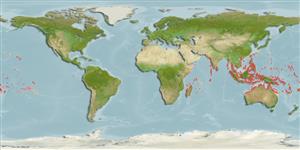Common names from other countries
Environment: milieu / climate zone / depth range / distribution range
Ecologie
Rifbewoner; diepteverspreiding 0 - 5 m (Ref. 75835). Tropical; 31°N - 28°S, 42°E - 124°W
Indo-Pacific.
Length at first maturity / Size / Gewicht / Leeftijd
Maturity: Lm ? range ? - ? cm Max length : 8.5 cm SHL mannelijk/geslacht niet bekend; (Ref. 821); common length : 5.0 cm SHL mannelijk/geslacht niet bekend; (Ref. 349); Maximaal vermelde leeftijd: 3.00 jaren (Ref. 117181)
One of the most frequently collected Turbinidae in the area, mainly for food. Shell also used as material for making buttons (Ref. 349). Sublittoral zone, in shallow water. Found in exposed areas of coral reefs (Ref. 349). Intertidal to 5 m, seaward on coral reefs (Ref. 75835). Herbivorous and detritus feeder (Ref. 107013).
Life cycle and mating behavior
Geslachtsrijpheid | Voortplanting | Kuitschieten | Eieren | Fecundity | Larven
Members of the order Patellogastropoda are mostly gonochoric and broadcast spawners. Life cycle: Embryos develop into planktonic trocophore larvae and later into juvenile veligers before becoming fully grown adults.
Poutiers, J.M. 1998. (Ref. 349)
Status op de Rode Lijst van het IUCN (Ref. 130435)
Status bij CITES (Ref. 108899)
Not Evaluated
Not Evaluated
Gevaarlijk voor mensen
Harmless
Gebruik door de mens
Visserij: commercieel
| FishSource | Sea Around Us
Tools
Internet-bronnen
Estimates based on models
Preferred temperature
(Ref.
115969): 25.6 - 29.3, mean 28.6 (based on 2967 cells).
Weerstandsvermogen
Hoog, minimale populatieverdubbelingstijd minder dan 15 maanden (K=0.58; tmax=3).
Prior r = 1.19, 95% CL = 0.79 - 1.79, Based on 1 data-limited stock assessment.
Kwetsbaarheid
Low vulnerability (10 of 100).
